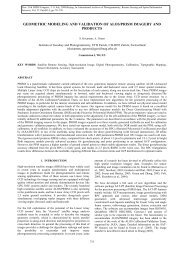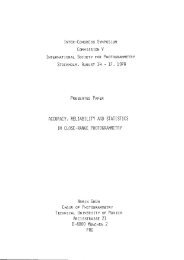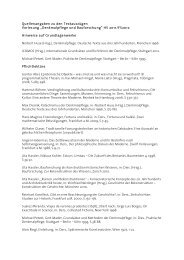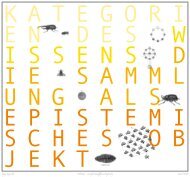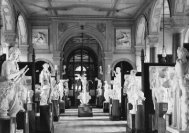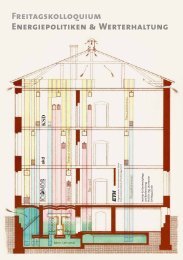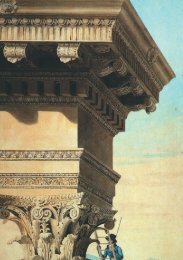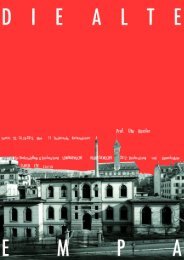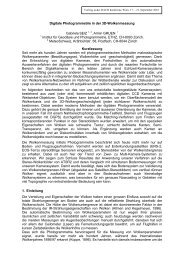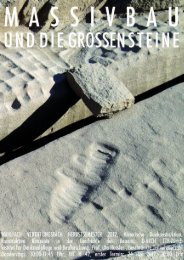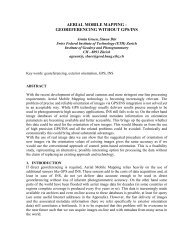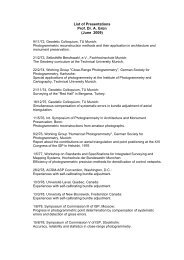Bautechnik im Historismus - IDB - ETH Zürich
Bautechnik im Historismus - IDB - ETH Zürich
Bautechnik im Historismus - IDB - ETH Zürich
You also want an ePaper? Increase the reach of your titles
YUMPU automatically turns print PDFs into web optimized ePapers that Google loves.
Building<br />
Techniques<br />
<strong>Bautechnik</strong><br />
in the Age<br />
<strong>Historismus</strong><br />
Planarchiv Amt für Hochbauten der Stadt Zürich<br />
of<br />
<strong>im</strong><br />
Historicism
Building Techniques in the<br />
Age of Historicism<br />
From Technical Theories on Gothic<br />
to Great Construction Sites<br />
<strong>Bautechnik</strong> <strong>im</strong> <strong>Historismus</strong><br />
Von den technischen Theorien über die<br />
Gotik bis zu den grossen Baustellen<br />
Symposium 17/18 February 2011<br />
Semper Aula, Main Building, <strong>ETH</strong> Zurich<br />
<strong>ETH</strong> Zürich und Universidad Politécnica de Madrid<br />
There was no Vitruvius for the Middle Ages. Architecture and construction did<br />
not have a universal theory. For this reason, scholars in the nineteenth century<br />
developed a theory of Gothic architecture with almost no guide, but the<br />
buildings themselves. They wondered about their origin, looked for the essential<br />
elements, studied the construction, searched for proportions — all at the same<br />
t<strong>im</strong>e. Exhaustive catalogues of buildings and building elements were made.<br />
The antiquarians and architects of the nineteenth century had more than an<br />
academical interest in Gothic: it was a style to build new buildings. The research<br />
on Gothic construction had its beginnings in the interest to learn how to build<br />
and how to design the structural elements. As a result, there is an enormous<br />
wealth of technical information about construction in the literature of the<br />
nineteenth century. Viollet-le-Duc or Choisy knew how to build a vault, they<br />
were present during works of masonry construction, had inspected demolished<br />
buildings, in summary, they were late inheritors of the millenary tradition of<br />
masonry construction. At the same t<strong>im</strong>e their view was determined by the<br />
nineteenth century perspective on construction. They worked in a t<strong>im</strong>e of<br />
transition, of mixed views and emerging techniques, of changing ideas and<br />
practices. The construction methods of the nineteenth century cannot be<br />
seen separated from the — especially towards the end of the century rapidly<br />
progressing — building techniques of the t<strong>im</strong>e.<br />
It is the purpose of this symposium to dwell on the construction of architecture<br />
in the nineteenth century, its structure, its methods and its technical theories.<br />
It is also the intention to begin to write another history of the nineteenth<br />
century Gothic revival: the history of the technical theories and carried-out<br />
constructions. This means, in many cases, to go directly to the sources and to the<br />
existing remains.<br />
Donnerstag, 17.2.2011 Freitag, 18.2.2011<br />
10.30–10.50<br />
Konstruieren als «Wissenschaft» und die Praktiken des Bauens<br />
Uta Hassler und Markus Peter, Zürich<br />
Bauen <strong>im</strong> 19. Jahrhundert –<br />
Die grossen Vollendungen und das Bauen <strong>im</strong> <strong>Historismus</strong><br />
10.50–11.30<br />
Die neugotische Vollendung des 19. Jahrhunderts – Der Kölner Dom<br />
Hans-Georg Lippert, Dresden<br />
11.30–12.10<br />
Entstehungsprozess eines neogotischen Landhauses – Toddington Manor<br />
Leo Schmidt, Cottbus<br />
12.10–12.50<br />
Das gotische Minarett. Zur hölzernen Bauwut des spätosmanischen Istanbul<br />
Martin Bachmann, Istanbul<br />
12.50–14.20 Mittagspause<br />
Bauen auf dem Blatt – Das Wissen über das Funktionieren<br />
14.20–15.00<br />
Viollet-le-Duc und die oberen Strebebögen<br />
Georg Germann, Bern<br />
15.00–15.40<br />
19th century Theories on Gothic Building Techniques in France<br />
Isabel Tarrio, Madrid<br />
15.40–16.20<br />
Some 19th century Sources for Viollet-le-Duc’s Ideas<br />
on Gothic Construction<br />
Martin Bressani, Montreal<br />
16.20–16.50 Kaffee<br />
16.50–17.30<br />
The Role of architectural Drawing in Auguste Choisy’s Interpretation<br />
of Gothic<br />
Javier Girón, Madrid<br />
17.30–18.10<br />
Georg Gottlob Ungewitters Lehrbuch der gotischen Konstruktionen<br />
Elena Pliego, Madrid<br />
18.10–18.50<br />
Robert Marks Analyse gotischer Konstruktionen<br />
Jürg Conzett, Chur<br />
Bau, Konstruktion, Ornamentform – Technische Möglichkeiten<br />
9.00–9.40<br />
Tragverhalten von Rippengewölben<br />
Rainer Barthel, München<br />
9.40–10.20<br />
Cross Arch-Vaults in Gothic and Neo-Gothic: The Transfer of an Islamic<br />
Form to European Gothic<br />
Paula Fuentes, Madrid<br />
10.30–10.50 Kaffee<br />
10.50–11.30<br />
Matériaux, techniques de construction et formes chez E.-E. Viollet-le-Duc:<br />
le cas de l’église Saint-Denis-de-L’Estrée<br />
Arnaud T<strong>im</strong>bert, Lille<br />
11.30–12.10<br />
Johann Claudius von Lassaulx’ Gewölbe «aus freier Hand» –<br />
Die Wiedererfindung der gotischen Architektur und die Entwicklung<br />
der technischen Literatur<br />
David Wendland, Dresden<br />
12.10–12.50<br />
«Natürliche» Formbildungsprozesse in der Neugotik Friedrich W. H. Göslings (1837–1899)<br />
Rainer Graefe, Innsbruck<br />
12.50–14.20 Mittagspause<br />
Bauen als Prozess – <strong>Bautechnik</strong> und die Baustelle<br />
14.20–15.00<br />
Technische Herausforderungen in der Konstruktion gotischer Gewölbe<br />
Santiago Huerta, Madrid<br />
15.00–15.40<br />
Konstruktion weitgespannter Münchener Dächer des 19. Jahrhunderts<br />
Stefan Holzer, München<br />
15.40–16.10 Kaffee<br />
16.10–16.50<br />
Die Baustelle um 1900 – Pragmatische Konstruktionen und Materialien?<br />
Christoph Rauhut, Zürich<br />
16.50–17.30<br />
Planen ohne Wörter – zur Kommunikation in gotischen Bauhütten<br />
Norbert Nußbaum, Köln<br />
Die Tradition des Polytechnischen – <strong>Bautechnik</strong> als Wissenschaft und Praxis<br />
Institut für Denkmalpflege und<br />
Bauforschung der <strong>ETH</strong> Zürich<br />
Prof. Dr. Uta Hassler<br />
CH-8093 Zürich<br />
www.idb.arch.ethz.ch<br />
Professur für Architektur und<br />
Konstruktion der <strong>ETH</strong> Zürich<br />
Prof. Markus Peter<br />
CH-8093 Zürich<br />
www.maerkli-peter.arch.ethz.ch<br />
Department of Structural Design<br />
Prof. Dr. Santiago Huerta<br />
Escuela Técnica Superior de Arquitectura<br />
Universidad Politécnica de Madrid<br />
E-28040 Madrid<br />
Unterstützt durch<br />
17.30–18.30<br />
Podiumsdiskussion<br />
Karl-Eugen Kurrer, Berlin; Tom F. Peters, Poschiavo; Joseph Schwartz, Zürich;<br />
Santiago Huerta, Madrid<br />
18.30 Apéro
<strong>Bautechnik</strong> <strong>im</strong> <strong>Historismus</strong><br />
Von den technischen Theorien über die Gotik bis zu den grossen Baustellen<br />
Building Techniques in the Age of Historicism<br />
From Technical Theories on Gothic to Great Construction Sites<br />
There was no Vitruvius for the Middle Ages. Architecture and construction did not have a<br />
universal theory. For this reason, scholars in the nineteenth century developed a theory of Gothic<br />
architecture with almost no guide, but the buildings themselves. They wondered about their<br />
origin, looked for the essential elements, studied the construction, searched for proportions—<br />
all at the same t<strong>im</strong>e. Exhaustive catalogues of buildings and building elements were made.<br />
The antiquarians and architects of the nineteenth century had more than an academical interest<br />
in Gothic: it was a style to build new buildings. The research on Gothic construction had its<br />
beginnings in the interest to learn how to build and how to design the structural elements. As a<br />
result, there is an enormous wealth of technical information about construction in the literature<br />
of the nineteenth century. Viollet-le-Duc or Choisy knew how to build a vault, they were present<br />
during works of masonry construction, had inspected demolished buildings, in summary, they<br />
were late inheritors of the millenary tradition of masonry construction. At the same t<strong>im</strong>e their<br />
view was determined by the nineteenth century perspective on construction. They worked in a<br />
t<strong>im</strong>e of transition, of mixed views and emerging techniques, of changing ideas and practices.<br />
The construction methods of the nineteenth century cannot be<br />
seen separated from the—especially towards the end of the century rapidly progressing—<br />
building techniques of the t<strong>im</strong>e.<br />
It is the purpose of this symposium to dwell on the construction of architecture in the<br />
nineteenth century, its structure, its methods and its technical theories.<br />
It is also the intention to begin to write another history of the nineteenth century Gothic revival:<br />
the history of the technical theories and carried-out constructions. This means, in many cases, to<br />
go directly to the sources and to the existing remains.<br />
Symposium 17/18 February 2011<br />
Semper Aula, Main Building, <strong>ETH</strong> Zurich<br />
Institut für Denkmalpflege und Professur für Architektur und Department of Structural Design<br />
Bauforschung der <strong>ETH</strong> Zürich Konstruktion der <strong>ETH</strong> Zürich Prof.Dr.Santiago Huerta<br />
Prof.Dr.Uta Hassler Prof.Markus Peter Escuela Técnica Superior de Arquitectura<br />
CH-8093 Zürich CH-8093 Zürich Universidad Politécnica de Madrid<br />
www.idb.arch.ethz.ch www.maerkli-peter.arch.ethz.ch E-28040 Madrid
Programm<br />
Donnerstag, 17.2.2011<br />
10.30–10.50<br />
Konstruieren als «Wissenschaft» und die Praktiken des Bauens<br />
Uta Hassler und Markus Peter, Zürich<br />
Bauen <strong>im</strong> 19.Jahrhundert – Die grossen Vollendungen und das Bauen <strong>im</strong> <strong>Historismus</strong><br />
10.50–11.30<br />
Die neugotische Vollendung des 19.Jahrhunderts – Der Kölner Dom<br />
Hans-Georg Lippert, Dresden<br />
11.30–12.10<br />
Entstehungsprozess eines neogotischen Landhauses – Toddington Manor<br />
Leo Schmidt, Cottbus<br />
12.10–12.50<br />
Das gotische Minarett. Zur hölzernen Bauwut des spätosmanischen Istanbul<br />
Martin Bachmann, Istanbul<br />
12.50–14.20 Mittagspause<br />
Bauen auf dem Blatt – Das Wissen über das Funktionieren<br />
14.20–15.00<br />
Viollet-le-Duc und die oberen Strebebögen<br />
Georg Germann, Bern<br />
15.00–15.40<br />
19th century Theories on Gothic Building Techniques in France<br />
Isabel Tarrio, Madrid<br />
15.40–16.20<br />
Some 19th century Sources for Viollet-le-Duc’s Ideas on Gothic Construction<br />
Martin Bressani, Montreal<br />
16.20–16.50 Kaffee<br />
16.50–17.30<br />
The Role of architectural Drawing in Auguste Choisy’s Interpretation of Gothic<br />
Javier Girón, Madrid
17.30–18.10<br />
Georg Gottlob Ungewitters Lehrbuch der gotischen Konstruktionen<br />
Elena Pliego, Madrid<br />
18.10–18.50<br />
Robert Marks Analyse gotischer Konstruktionen<br />
Jürg Conzett, Chur<br />
Freitag, 18.2.2011<br />
Bau, Konstruktion, Ornamentform – Technische Möglichkeiten<br />
9.00–9.40<br />
Tragverhalten von Rippengewölben<br />
Rainer Barthel, München<br />
9.40–10.20<br />
Cross-Arch Vaults in Gothic and Neo-Gothic: The Transfer of an Islamic Form to European Gothic<br />
Paula Fuentes and Santiago Huerta, Madrid<br />
10.30–10.50 Kaffee<br />
10.50–11.30<br />
Matériaux, techniques de construction et formes chez E.-E. Viollet-le-Duc:<br />
le cas de l’église Saint-Denis-de-L’Estrée<br />
Arnaud T<strong>im</strong>bert, Lille<br />
11.30–12.10<br />
Johann Claudius von Lassaulx’ Gewölbe «aus freier Hand» –<br />
Die Wiedererfindung der gotischen Architektur und die Entwicklung der technischen Literatur<br />
David Wendland, Dresden<br />
12.10–12.50<br />
«Natürliche» Formbildungsprozesse in der Neugotik Friedrich W. H. Göslings (1837–1899)<br />
Rainer Graefe, Innsbruck<br />
12.50–14.20 Mittagspause<br />
Bauen als Prozess – <strong>Bautechnik</strong> und die Baustelle<br />
14.20–15.00<br />
Technische Herausforderungen in der Konstruktion gotischer Gewölbe<br />
Santiago Huerta, Madrid
15.00–15.40<br />
Konstruktion weitgespannter Münchener Dächer des 19.Jahrhunderts<br />
Stefan Holzer, München<br />
15.40–16.10 Kaffee<br />
16.10–16.50<br />
Die Baustelle um 1900 – Pragmatische Konstruktionen und Materialien?<br />
Christoph Rauhut, Zürich<br />
16.50–17.30<br />
Planen ohne Wörter – zur Kommunikation in gotischen Bauhütten<br />
Norbert Nußbaum, Köln<br />
Die Tradition des Polytechnischen – <strong>Bautechnik</strong> als Wissenschaft und Praxis<br />
17.30–18.30<br />
Podiumsdiskussion<br />
Karl-Eugen Kurrer, Berlin; Tom F. Peters, Poschiavo; Joseph Schwartz, Zürich; Santiago Huerta,<br />
Madrid<br />
18.30 Apéro




